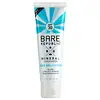What's inside
What's inside
 Key Ingredients
Key Ingredients

 Benefits
Benefits

 Concerns
Concerns

 Ingredients Side-by-side
Ingredients Side-by-side

Water
Skin ConditioningButyloctyl Salicylate
Skin ConditioningGlycerin
HumectantIsohexadecane
EmollientCarthamus Tinctorius Oleosomes
EmollientNiacinamide
SmoothingDimethicone
EmollientC12-15 Alkyl Benzoate
AntimicrobialPolyglyceryl-10 Stearate
Skin ConditioningAmmonium Acryloyldimethyltaurate/Vp Copolymer
Theobroma Cacao Seed Extract
AntioxidantDimethicone Crosspolymer
Emulsion StabilisingXanthan Gum
EmulsifyingParfum
MaskingButylene Glycol
HumectantCitric Acid
BufferingSodium Benzoate
MaskingTocopheryl Acetate
AntioxidantCoumarin
PerfumingHexyl Cinnamal
PerfumingLimonene
PerfumingLinalool
PerfumingWater, Butyloctyl Salicylate, Glycerin, Isohexadecane, Carthamus Tinctorius Oleosomes, Niacinamide, Dimethicone, C12-15 Alkyl Benzoate, Polyglyceryl-10 Stearate, Ammonium Acryloyldimethyltaurate/Vp Copolymer, Theobroma Cacao Seed Extract, Dimethicone Crosspolymer, Xanthan Gum, Parfum, Butylene Glycol, Citric Acid, Sodium Benzoate, Tocopheryl Acetate, Coumarin, Hexyl Cinnamal, Limonene, Linalool
Zinc Oxide 18.2%
Cosmetic ColorantAcrylates Copolymer
Aloe Barbadensis Flower Extract
EmollientAloe Barbadensis Leaf Juice
Skin ConditioningAlpha-Ionone
PerfumingButyrospermum Parkii Butter
Skin ConditioningCaprylic/Capric Triglyceride
MaskingCaprylyl Glycol
EmollientCitric Acid
BufferingCoccinia Indica Fruit Extract
Skin ConditioningCorallina Officinalis Extract
Skin ConditioningCucumis Sativus Fruit Extract
EmollientCurcuma Longa Root Extract
MaskingDecanal
MaskingDelta-Dodecalactone
PerfumingDidecyldimonium Chloride
EmulsifyingDimethicone
EmollientDimethylheptenal
PerfumingEthyl Ferulate
AntioxidantGamma-Nonalactone
MaskingGamma-Octalactone
PerfumingGamma-Undecalactone
PerfumingGlycerin
HumectantGlyceryl Stearate Se
Emulsifying3-Hexenol
MaskingHexyl Acetate
MaskingJuniperus Virginiana Oil
MaskingLauryl Glucoside
CleansingMelia Azadirachta Flower Extract
Skin ConditioningMelia Azadirachta Leaf Extract
Skin ConditioningMethyl Dihydroabietate
Methylpropanediol
SolventOcimum Basilicum Flower/Leaf Extract
TonicOcimum Sanctum Leaf Extract
Skin ConditioningOlive Oil Polyglyceryl-6 Esters
EmollientPolyacrylate Crosspolymer-6
Emulsion StabilisingPolyhydroxystearic Acid
EmulsifyingPolymethylsilsesquioxane
Polyquaternium-80
CleansingPolysilicone-11
Propylheptyl Caprylate
EmollientSolanum Melongena Fruit Extract
Skin ConditioningSorbitan Stearate
EmulsifyingSorbityl Laurate
EmulsifyingTridecane
PerfumingTriethoxycaprylylsilane
Triethyl Citrate
MaskingUndecane
EmollientWater
Skin ConditioningXanthan Gum
EmulsifyingZinc Oxide 18.2%, Acrylates Copolymer, Aloe Barbadensis Flower Extract, Aloe Barbadensis Leaf Juice, Alpha-Ionone, Butyrospermum Parkii Butter, Caprylic/Capric Triglyceride, Caprylyl Glycol, Citric Acid, Coccinia Indica Fruit Extract, Corallina Officinalis Extract, Cucumis Sativus Fruit Extract, Curcuma Longa Root Extract, Decanal, Delta-Dodecalactone, Didecyldimonium Chloride, Dimethicone, Dimethylheptenal, Ethyl Ferulate, Gamma-Nonalactone, Gamma-Octalactone, Gamma-Undecalactone, Glycerin, Glyceryl Stearate Se, 3-Hexenol, Hexyl Acetate, Juniperus Virginiana Oil, Lauryl Glucoside, Melia Azadirachta Flower Extract, Melia Azadirachta Leaf Extract, Methyl Dihydroabietate, Methylpropanediol, Ocimum Basilicum Flower/Leaf Extract, Ocimum Sanctum Leaf Extract, Olive Oil Polyglyceryl-6 Esters, Polyacrylate Crosspolymer-6, Polyhydroxystearic Acid, Polymethylsilsesquioxane, Polyquaternium-80, Polysilicone-11, Propylheptyl Caprylate, Solanum Melongena Fruit Extract, Sorbitan Stearate, Sorbityl Laurate, Tridecane, Triethoxycaprylylsilane, Triethyl Citrate, Undecane, Water, Xanthan Gum
Ingredients Explained
These ingredients are found in both products.
Ingredients higher up in an ingredient list are typically present in a larger amount.
Citric Acid is an alpha hydroxy acid (AHA) naturally found in citrus fruits like oranges, lemons, and limes.
Like other AHAs, citric acid can exfoliate skin by breaking down the bonds that hold dead skin cells together. This helps reveal smoother and brighter skin underneath.
However, this exfoliating effect only happens at high concentrations (20%) which can be hard to find in cosmetic products.
Due to this, citric acid is usually included in small amounts as a pH adjuster. This helps keep products slightly more acidic and compatible with skin's natural pH.
In skincare formulas, citric acid can:
While it can provide some skin benefits, research shows lactic acid and glycolic acid are generally more effective and less irritating exfoliants.
Most citric acid used in skincare today is made by fermenting sugars (usually from molasses). This synthetic version is identical to the natural citrus form but easier to stabilize and use in formulations.
Read more about some other popular AHA's here:
Learn more about Citric AcidDimethicone is a type of synthetic silicone created from natural materials such as quartz.
What it does:
Dimethicone comes in different viscosities:
Depending on the viscosity, dimethicone has different properties.
Ingredients lists don't always show which type is used, so we recommend reaching out to the brand if you have questions about the viscosity.
This ingredient is unlikely to cause irritation because it does not get absorbed into skin. However, people with silicone allergies should be careful about using this ingredient.
Note: Dimethicone may contribute to pilling. This is because it is not oil or water soluble, so pilling may occur when layered with products. When mixed with heavy oils in a formula, the outcome is also quite greasy.
Learn more about DimethiconeGlycerin is already naturally found in your skin. It helps moisturize and protect your skin.
A study from 2016 found glycerin to be more effective as a humectant than AHAs and hyaluronic acid.
As a humectant, it helps the skin stay hydrated by pulling moisture to your skin. The low molecular weight of glycerin allows it to pull moisture into the deeper layers of your skin.
Hydrated skin improves your skin barrier; Your skin barrier helps protect against irritants and bacteria.
Glycerin has also been found to have antimicrobial and antiviral properties. Due to these properties, glycerin is often used in wound and burn treatments.
In cosmetics, glycerin is usually derived from plants such as soybean or palm. However, it can also be sourced from animals, such as tallow or animal fat.
This ingredient is organic, colorless, odorless, and non-toxic.
Glycerin is the name for this ingredient in American English. British English uses Glycerol/Glycerine.
Learn more about GlycerinWater. It's the most common cosmetic ingredient of all. You'll usually see it at the top of ingredient lists, meaning that it makes up the largest part of the product.
So why is it so popular? Water most often acts as a solvent - this means that it helps dissolve other ingredients into the formulation.
You'll also recognize water as that liquid we all need to stay alive. If you see this, drink a glass of water. Stay hydrated!
Learn more about WaterXanthan gum is used as a stabilizer and thickener within cosmetic products. It helps give products a sticky, thick feeling - preventing them from being too runny.
On the technical side of things, xanthan gum is a polysaccharide - a combination consisting of multiple sugar molecules bonded together.
Xanthan gum is a pretty common and great ingredient. It is a natural, non-toxic, non-irritating ingredient that is also commonly used in food products.
Learn more about Xanthan Gum